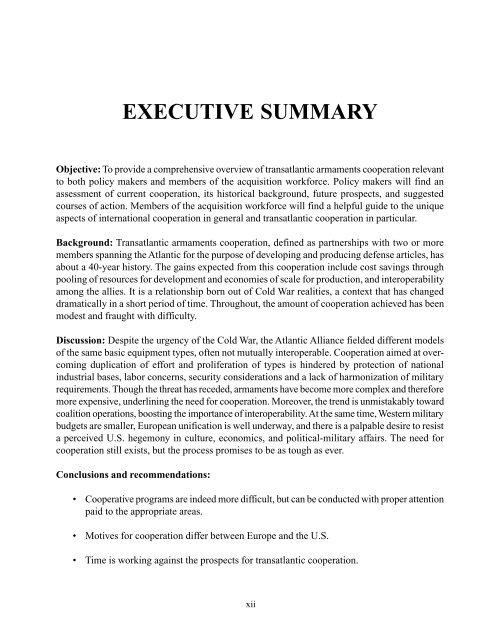Transatlantic Armaments Cooperation - Federation of American ...
Transatlantic Armaments Cooperation - Federation of American ...
Transatlantic Armaments Cooperation - Federation of American ...
Create successful ePaper yourself
Turn your PDF publications into a flip-book with our unique Google optimized e-Paper software.
EXECUTIVE SUMMARY<br />
Objective: To provide a comprehensive overview <strong>of</strong> transatlantic armaments cooperation relevant<br />
to both policy makers and members <strong>of</strong> the acquisition workforce. Policy makers will find an<br />
assessment <strong>of</strong> current cooperation, its historical background, future prospects, and suggested<br />
courses <strong>of</strong> action. Members <strong>of</strong> the acquisition workforce will find a helpful guide to the unique<br />
aspects <strong>of</strong> international cooperation in general and transatlantic cooperation in particular.<br />
Background: <strong>Transatlantic</strong> armaments cooperation, defined as partnerships with two or more<br />
members spanning the Atlantic for the purpose <strong>of</strong> developing and producing defense articles, has<br />
about a 40-year history. The gains expected from this cooperation include cost savings through<br />
pooling <strong>of</strong> resources for development and economies <strong>of</strong> scale for production, and interoperability<br />
among the allies. It is a relationship born out <strong>of</strong> Cold War realities, a context that has changed<br />
dramatically in a short period <strong>of</strong> time. Throughout, the amount <strong>of</strong> cooperation achieved has been<br />
modest and fraught with difficulty.<br />
Discussion: Despite the urgency <strong>of</strong> the Cold War, the Atlantic Alliance fielded different models<br />
<strong>of</strong> the same basic equipment types, <strong>of</strong>ten not mutually interoperable. <strong>Cooperation</strong> aimed at overcoming<br />
duplication <strong>of</strong> effort and proliferation <strong>of</strong> types is hindered by protection <strong>of</strong> national<br />
industrial bases, labor concerns, security considerations and a lack <strong>of</strong> harmonization <strong>of</strong> military<br />
requirements. Though the threat has receded, armaments have become more complex and therefore<br />
more expensive, underlining the need for cooperation. Moreover, the trend is unmistakably toward<br />
coalition operations, boosting the importance <strong>of</strong> interoperability. At the same time, Western military<br />
budgets are smaller, European unification is well underway, and there is a palpable desire to resist<br />
a perceived U.S. hegemony in culture, economics, and political-military affairs. The need for<br />
cooperation still exists, but the process promises to be as tough as ever.<br />
Conclusions and recommendations:<br />
• Cooperative programs are indeed more difficult, but can be conducted with proper attention<br />
paid to the appropriate areas.<br />
• Motives for cooperation differ between Europe and the U.S.<br />
• Time is working against the prospects for transatlantic cooperation.<br />
xii
















